

TRANSFORMING INTO A CITY IN NATURE
Greenery is essential in strengthening Singapore’s environmental resilience and mitigating the effects of climate change. Backed by science, empowered by technology and supported by the community, NParks' greening effort is key to providing a quality living environment for all in Singapore.
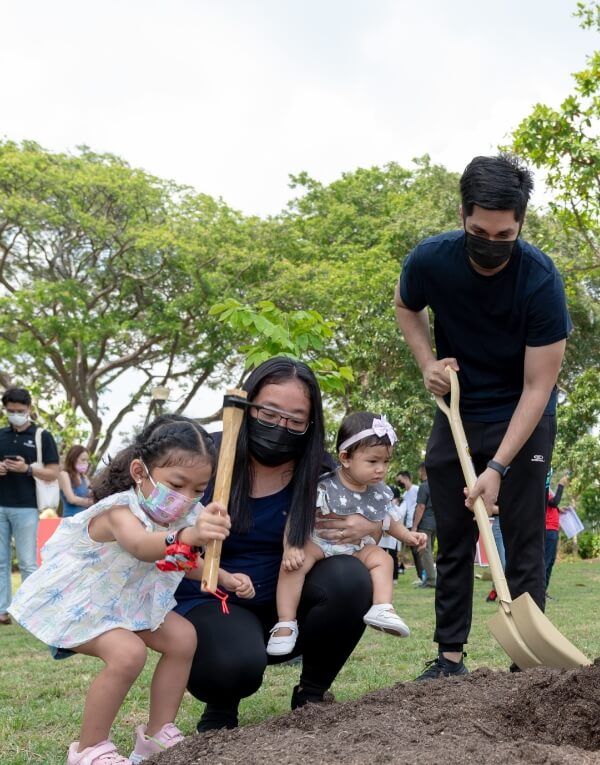
In the year since its launch in March 2022, more than 450 families have participated in the FamilyTrees initiative.
OneMillionTrees
movement stands
strong
The benefits of trees are well documented – they improve the physical, mental and social aspects of community well-being while enhancing our resilience towards climate change. The OneMillionTrees movement that began in 2020 achieved a milestone in April 2023 with more than 500,000 trees planted throughout Singapore, thanks to the efforts of some 75,000 members of the community. At this pace, the initiative is on track to achieve its goal of planting one million additional trees by 2027, three years ahead of schedule.
Learn more about the OneMillionTrees movment.
THE SCIENCE BEHIND PLANTING TREES
Greenery not only improves air quality by absorbing carbon dioxide and releasing oxygen during photosynthesis, but also brings about other benefits. The planting of trees and shrubs provides habitats and food for native wildlife, enhances the ecological connectivity of green spaces and creates conditions for native species to survive.
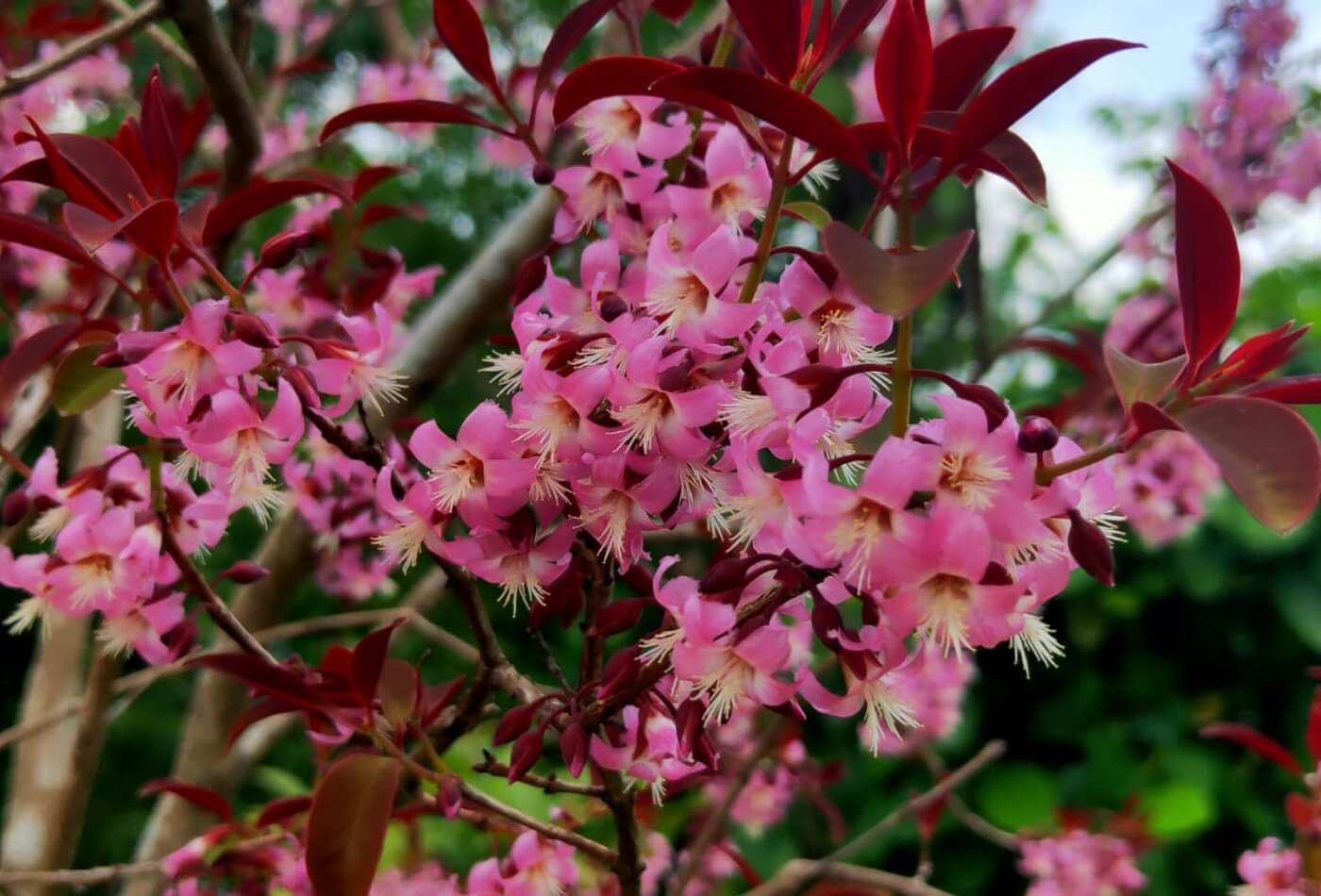
The native Cratoxylum maingayi planted along streetscapes attracts butterflies and other insects into our urban areas.
Enabling access
across the Tyersall-
Gallop Core
The opening of the 200 m HPL Canopy Link on 17 November 2022 marked the completion of the Tyersall-Gallop Core of the Singapore Botanic Gardens, extending its forest habitats and plant collections while buffering the UNESCO World Heritage Site from urban development. Visitors can now use the 2.4 m wide barrier-free pedestrian bridge that crosses Tyersall Avenue to move easily to all parts of the Gardens including the ridgetop forest habitats at Mingxin Foundation Rambler's Ridge.
Over at the Gallop Extension, the Botanical Art Gallery hosted an exclusive exhibition on “Flower Obsession: Plant Collecting in East Asia, 1600s–1900s”. This was the first time the Gallery featured artwork from overseas institutions. Many books, manuscripts and photographs dating as far back as the late 1600s from the Higashiyama Botanical Gardens and the private Soukaen Bunko in Nagoya, Japan, were exhibited outside Japan for the first time.
The latest exhibition at the Gallery, "Tropical Forest Sceneries: Singapore & Beyond" encapsulates the changing forest landscapes in the region and showcases for the first time, the stunning photographs of Edred John Henry Corner, a botanist and former Assistant Director of the Singapore Botanic Gardens.
These exhibitions gave visitors insight into the importance of plant documentation and botanical art to the Gardens’ research collection
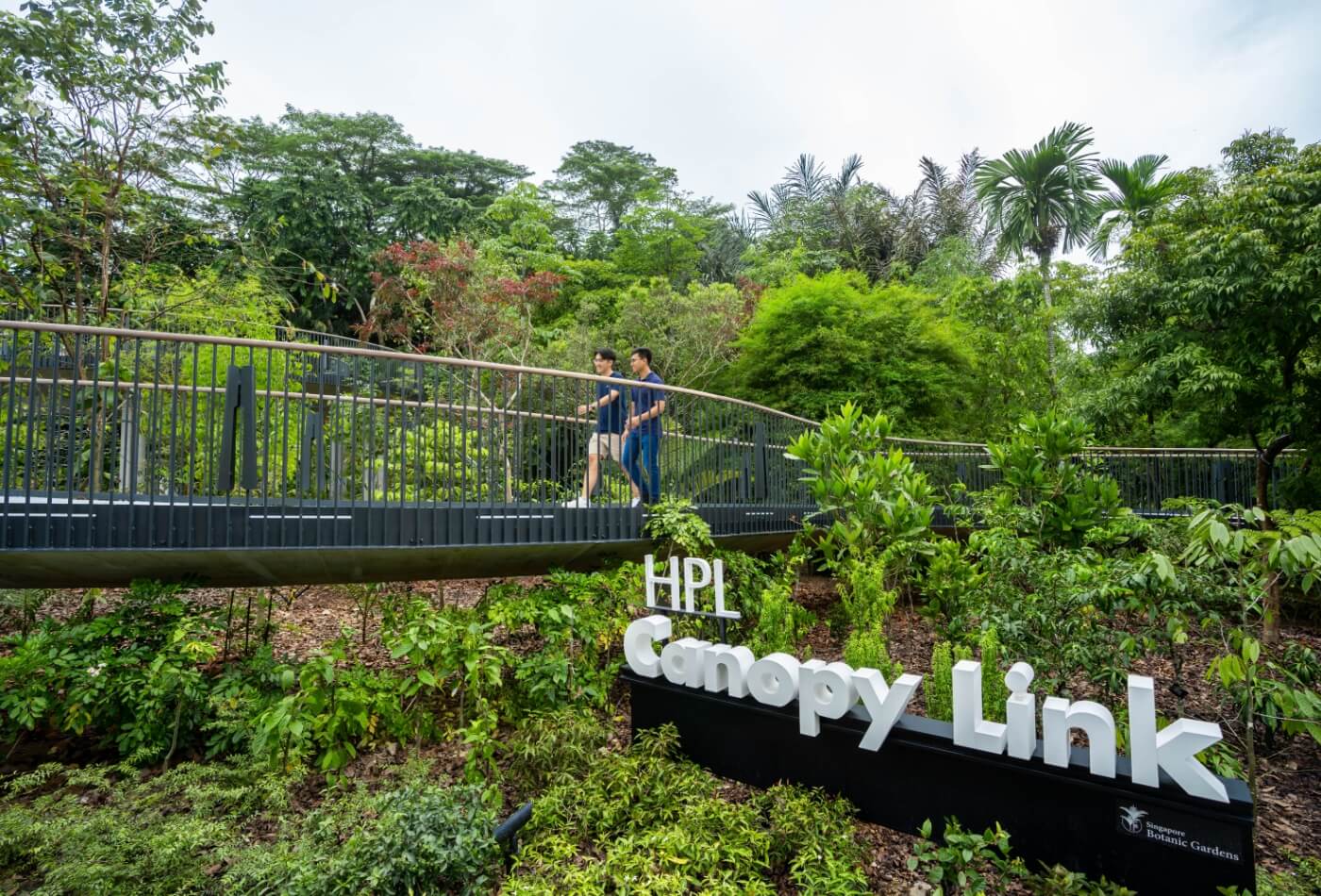
The HPL Canopy Link connects the Gallop Extension to rest of the Singapore Botanic Gardens via a scenic elevated walkway that weaves through trees that can be found in the lowland deciduous forests of continental Southeast Asia.
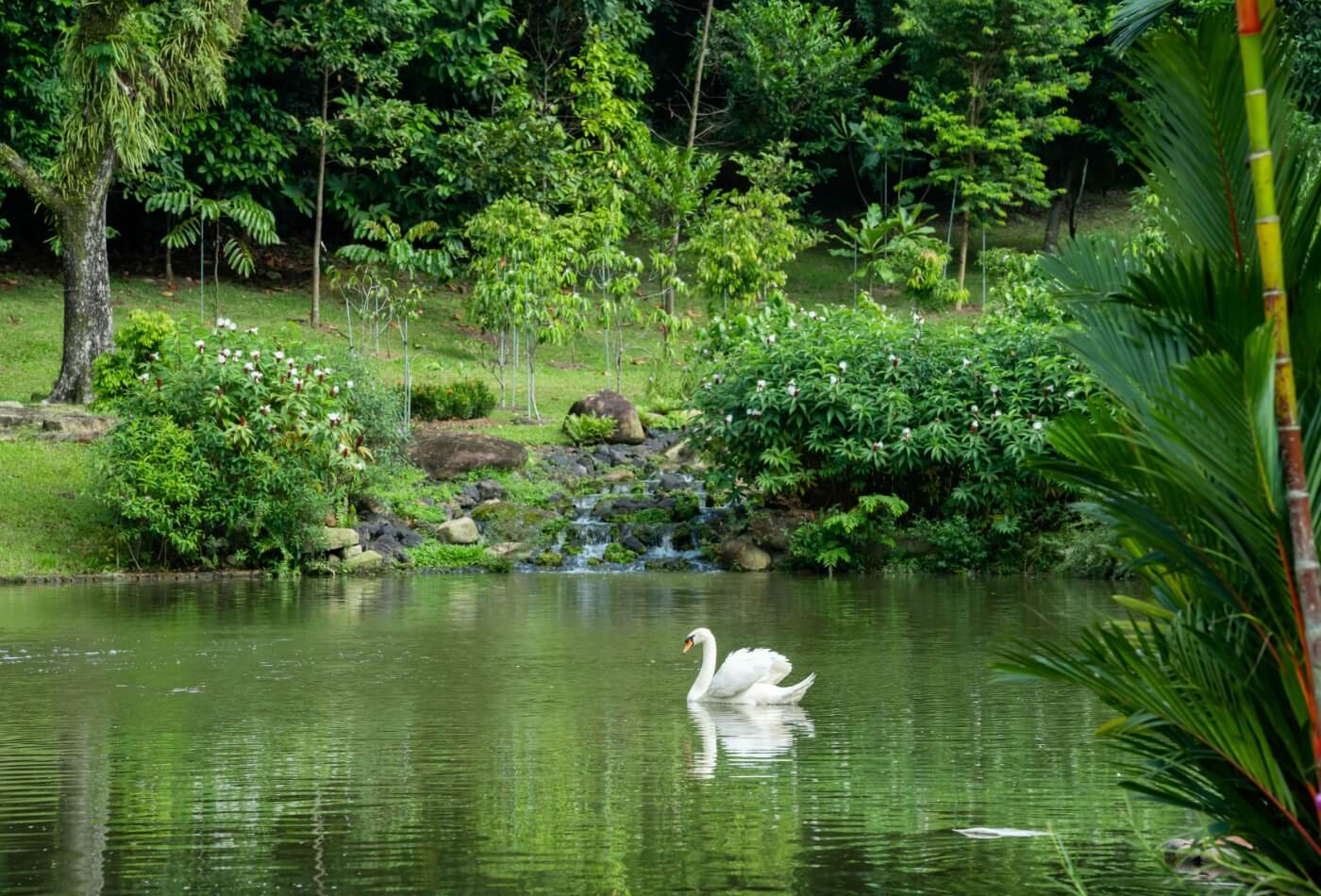
Enhancements to the swan pond in the Istana include naturalising the landscape and the addition of a new viewing deck.
Naturalising
the Istana Landscape
In the heart of the city, President Halimah Yacob officially opened the enhanced Swan Pond at the Istana. Originally constructed in 1968, sensitive enhancements made around the Swan Pond include the naturalisation of its drainage channel into a garden stream that acts as a bioswale.
Creating park
experiences
for all
NParks has completed the development of the 60 ha Lakeside Garden, one of three gardens within Jurong Lake Gardens which will also include the upcoming Chinese and Japanese Gardens. The community can now enjoy the new northern section of Lakeside Garden, an active zone with youth-oriented amenities that expand the range of experiences for visitors.
Advancing its reputation as a people’s garden, Jurong Lake Gardens hosted several family-centric events in 2022. The Lights by the Lake festival made a strong comeback after two years of pandemic restrictions, drawing more than 400,000 visitors with its lantern displays.
Gardening enthusiasts also returned to the Gardens for SustainableFest SG, enjoying gardening workshops, musical performances, guided walks and craft sessions for children over two weekends in May and June 2022.

President Halimah Yacob (left) greets visitors at Lights by the Lake 2022. The festival was organised in conjunction with the President's Challenge to celebrate the nation's strength and resilience against diversity.
Discover new attractions in Lakeside Garden.
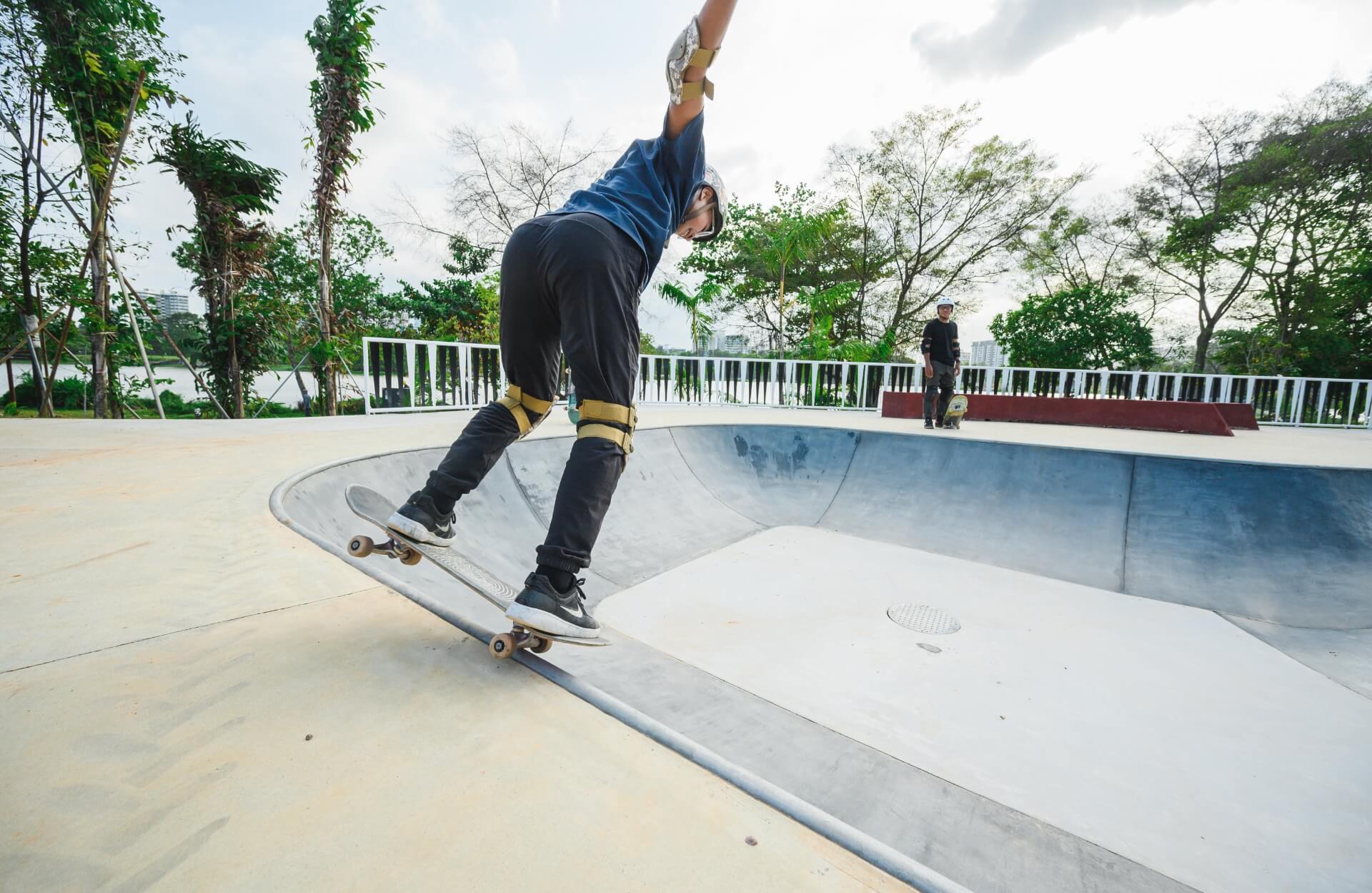
Designed in consultation with the community, SkatePark @ Lakeside Garden features the largest outdoor skate park in Singapore as well as a parkour park and bouldering wall set within nature.
JURONG LAKE GARDENS PIONEERS NEW TECHNOLOGIES
Jurong Lake Gardens provides a platform for partners to test-bed smart solutions that support sustainable park operations, with a view to scaling their deployment if they prove to be successful.
An example is the Integrated Garden Management System to which various environmental and facilities monitoring sensors are integrated, allowing for enhanced situational awareness, faster operational response, and improved visitor experience.
Another project is the deployment of autonomous robot "JuLee" to assist visitors with directions and essential information. JuLee is also equipped with advanced video analytics capabilities and alerts officers to prohibited activities in the Gardens.

Curious park users can ‘talk’ to JuLee about what to do in Jurong Lake Gardens or even where to find the nearest toilet.
Digging into the
history of Fort
Canning Park
200 years on, landscaping and greening works continue to revitalise Fort Canning Hill. Two new attractions were launched at Fort Canning Park to highlight the park’s historical and natural heritage. The Fort Canning Heritage Gallery, which opened in August 2022, allows visitors to explore the 700-year history of Fort Canning Hill. Highlights include archaeological artefacts such as glass shards, ceramic fragments and coins excavated from sites within Fort Canning Park.
Park goers can also expand their botanical knowledge with a visit to the enhanced Spice Garden, which sits on the site of Singapore's first botanical and experimental garden established in 1822.
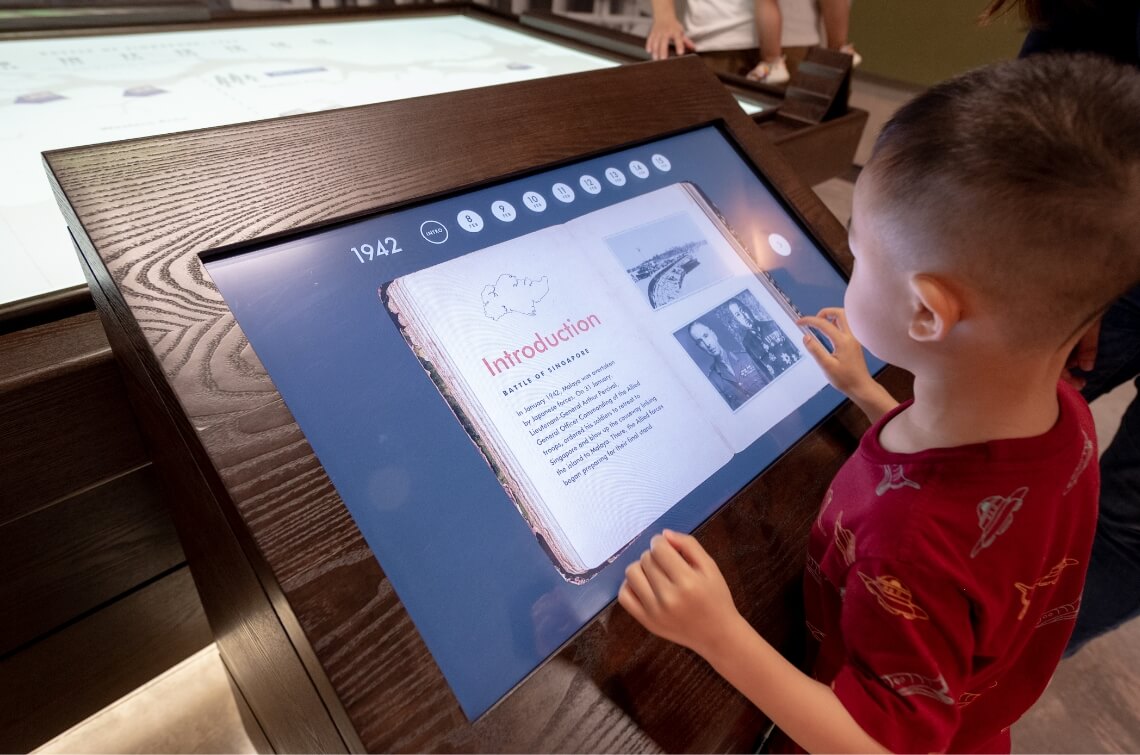
Animated stories and games on interactive screens around the Fort Canning Heritage Gallery bring history to life for young visitors.
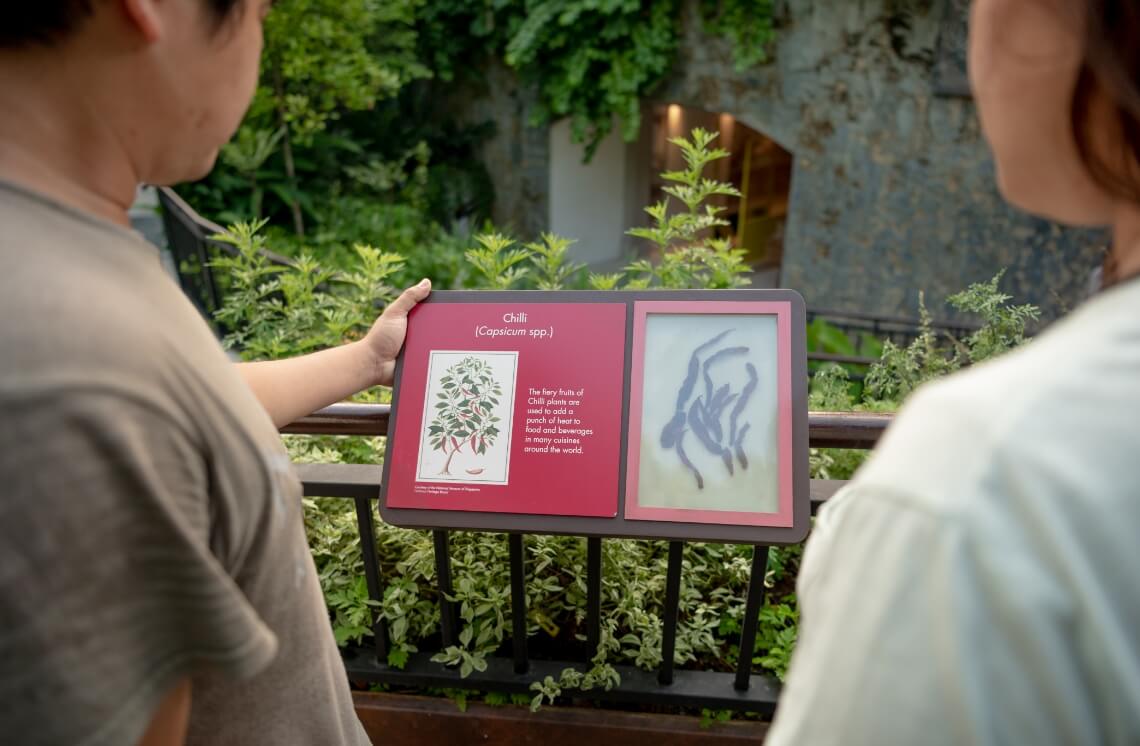
Visitors to the Spice Garden at Fort Canning Park can appreciate botanical artwork and dried specimens of select spices through the interpretive panels in the garden.
Orchard Road
goes green
Plans are underway to transform the Orchard Road shopping belt into a verdant urban corridor. As part of plans to “Bring Back the Orchard”, greenery along Orchard Road will be enhanced to feature pocket parks, gardens, and multilayered planting of shrubs and trees. The 1.3 ha Istana Park will be expanded to thrice its current size, incorporating existing green spaces such as Dhoby Ghaut Green and the Penang Road Open Space.
ION Orchard and Ngee Ann City, together with the Singapore Botanic Gardens, also served as the venue for the 8th Singapore Garden Festival which took place from 30 July to 9 August 2022. An event highlight was the Community Garden Edibles Competition at ION Orchard, which featured more than 400 fruit and vegetable entries submitted by gardening enthusiasts.
As part of the Festival, the Singapore Gardeners’ Cup 2022 was held at the Eco-Garden at the Singapore Botanic Gardens. Community in Bloom (CIB) gardening groups from public and private estates, schools, and organisations came together to create garden showcases with the theme Gardeners’ Fantasia.
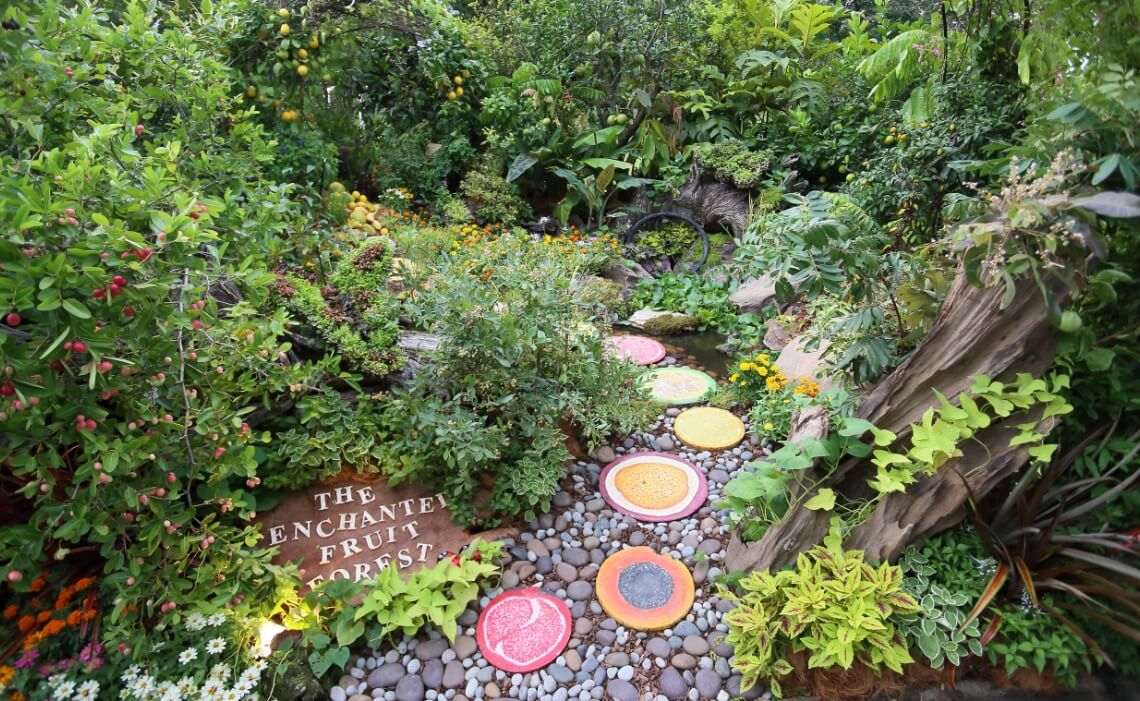
A miniature fruit orchard was the theme of one of the Gardeners' Cup displays for the Singapore Garden Festival held at the Singapore Botanic Gardens.
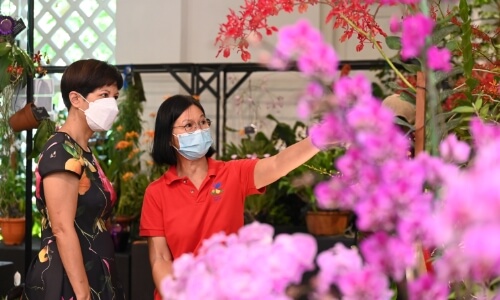
Minister in the Prime Minister's Office, and Second Minister for Finance and Second Minister for National Development Indranee Rajah (left) visits the Orchid Competition at the National Orchid Garden as part of the 8th Singapore Garden Festival, where the region's best orchid varieties and hybrids were put on display by dedicated hobbyists and professional growers.
Community
gardening
flourishes
Strong community involvement is vital for Singapore's transformation into a City in Nature. It is also a core pillar of the Singapore Green Plan 2030, the national movement to advance sustainable development and combat climate change.
The CIB movement aims to promote a gardening culture and cultivate community spirit among Singaporeans of all ages. Its gardening framework includes allotment gardening, gardening with edibles and corridor gardening which targets households.
In 2022, the CIB Awards were introduced to recognise the efforts of gardeners in enhancing the living environment, horticultural excellence and social outreach. A total of 373 community gardens from private and public housing estates participated in the competition, and 10 were recognised as Gardens of the Year.
To date, more than 1,900 community gardens have been established, including 80 that were launched in 2022. Some 110 new allotment plots were also built and offered at Ang Mo Kio Town Garden West, Kent Ridge Park and Sembawang Park, bringing the total to 2,200 allotment plots in 25 parks islandwide.
NParks continues to work with the Housing & Development Board (HDB), town councils and grassroots organisations to scale up the construction of allotment gardens in heartland areas, and facilitate community-led initiatives such as the development of the West Coast and East Coast Greenery Plans, as well as the Boon Lay and Taman Jurong Allotment Garden Masterplans, among others.
Virtually visit the ActiveSG Woodlands Sports Centre Community Garden.
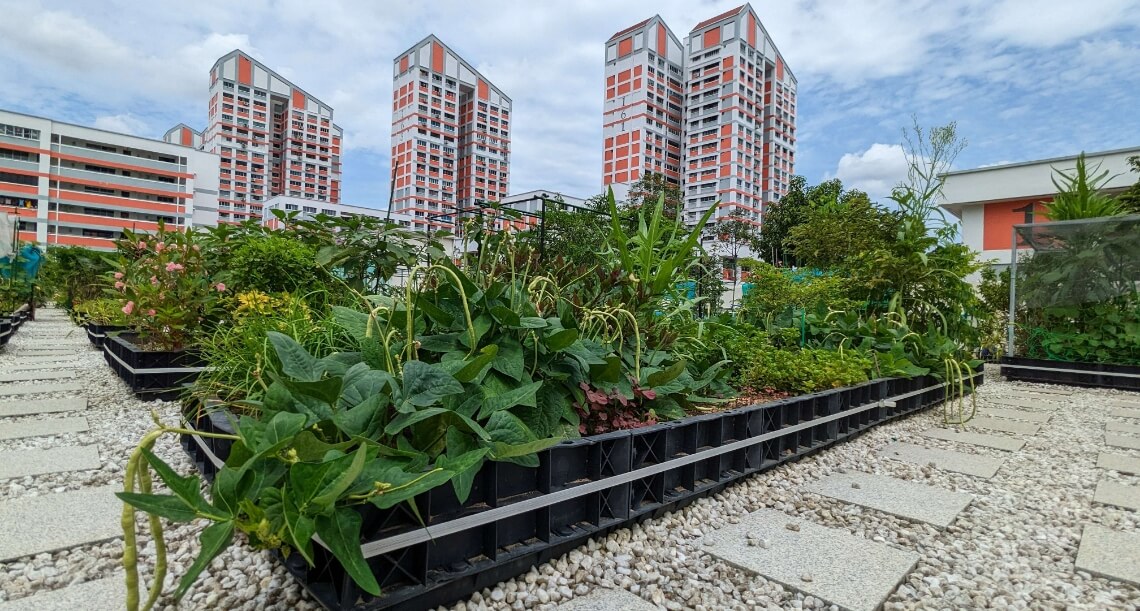
Community gardens like this one in Bishan have been sprouting up on carpark rooftops, expanding Singapore's skyrise greenery coverage.
Skyrise
greenery reaches
new heights
In other greening efforts, more than 12 ha of skyrise greenery were incorporated into buildings in the past year, expanding the total footprint to 155 ha.
Under the Skyrise Greenery Incentive Scheme which seeks to encourage the installation of vertical greenery on existing buildings, a multi-storey carpark rooftop at Bishan was converted into a thriving rooftop community garden with 350 gardening plots for residents. Another notable project was the building of an over 910 sqm green wall facade at Keppel Infrastructure @ Changi, which demonstrates the co-location of green walls and vertical photovoltaic panels.
USING NATURE TO IMPROVE CLIMATE RESILIENCE
Skyrise greenery is a nature-based strategy aimed at mitigating urban heat and noise through the greening of facades, balconies, as well as mid-level and roof spaces. Vertical greenery on building facades can lower surface temperatures by up to 11°C and reduce noise levels in the building by up to 10dB by absorbing sound. With rooftop gardens and sky terraces also acting as community spaces, skyrise greenery has the potential to enhance our climate, social and ecological resilience
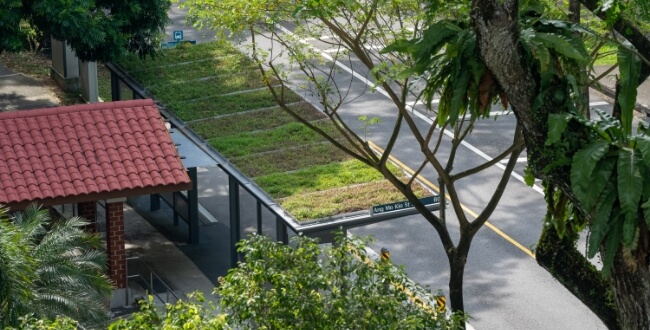
Studies have shown that green roofs, such as those found at select bus stops in Singapore, can reduce ambient temperatures by about 2°C.
Greening
industrial zones
To mitigate the urban heat island effect, particularly in the warmer industrial zones, NParks planted over 22,000 trees in industrial estates over the past year and completed the greening of Jurong Island by planting an additional 8,200 trees in collaboration with Jurong Town Corporation (JTC). This brought the total number of trees in industrial estates to over 100,000, including 34,000 trees on Jurong Island.
Such greening efforts extend beyond the industrial zones. NParks implemented landscape enhancements of nine newly-constructed MRT stations along the Thomson-East Coast Line. Together with the Land Transport Authority, over 5 km of new covered linkways were also greened up, expanding the coverage of Singapore's sheltered walkway network. Green roofs have been installed on 29 bus shelters in neighbourhoods like Ang Mo Kio and Pasir Ris and will be progressively rolled out to more bus shelters islandwide over the next two years.
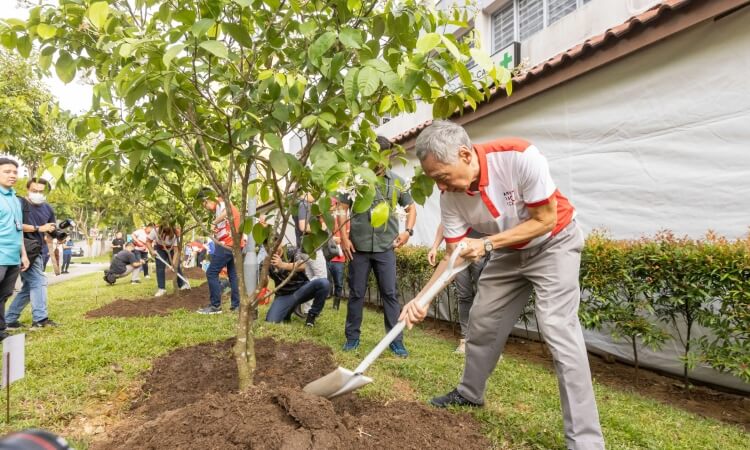
Prime Minister Lee Hsien Loong plants a tree during Clean and Green Singapore 2022, contributing to the OneMillionTrees movement.
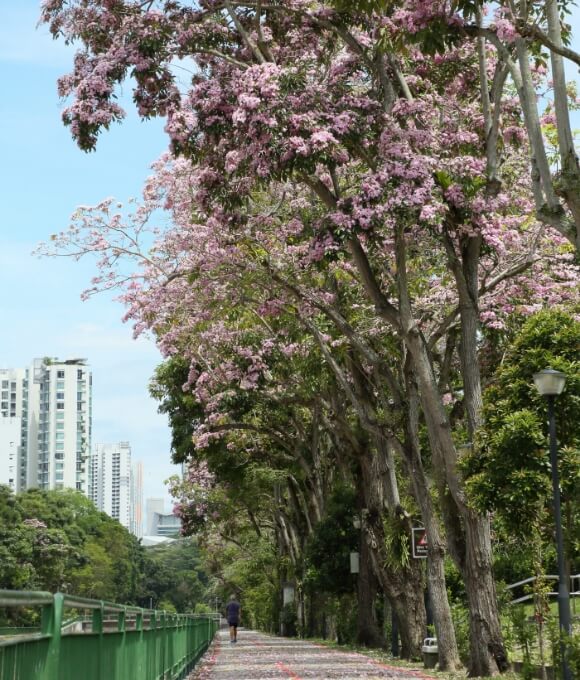
After periods of intense rain, the Trumpet Tree (Tabebuia rosea) also known as Singapore's version of the 'Sakura', grace our Park Connectors and streetscapes
Connecting
people and parks
In 2022, 10 km of Park Connector Network (PCN) routes were completed at Pang Sua North Bank, Tampines Avenue 10 and Simpang Kanan among other locations, bringing the total length of park connectors to 380 km. The PCN links up housing estates with parks, bringing nature closer to Singaporeans' doorstep.
THE SCIENCE OF PLAY
Nature playgardens encourage experiential learning and unstructured play among children. They are based on the biophilia hypothesis that humans possess an innate tendency to seek connections with nature. To date, there are 26 nature playgardens islandwide, including the latest ones in Pasir Ris Park and Pasir Panjang Park.
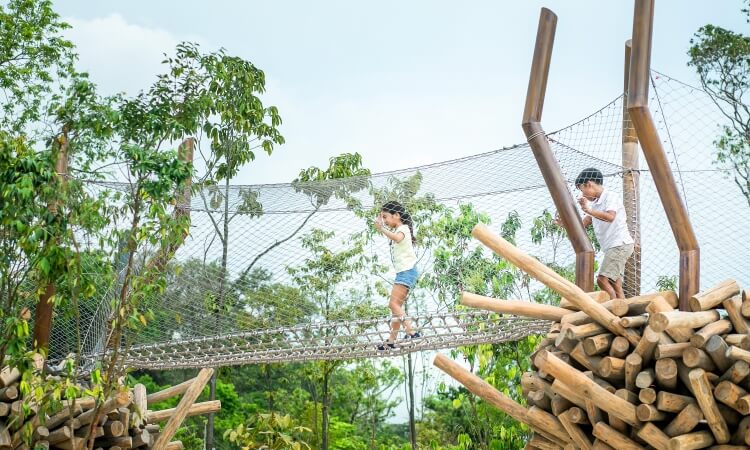
Built with natural materials and nestled among greenery, Nature Playgardens provide children with a closer experience with nature.
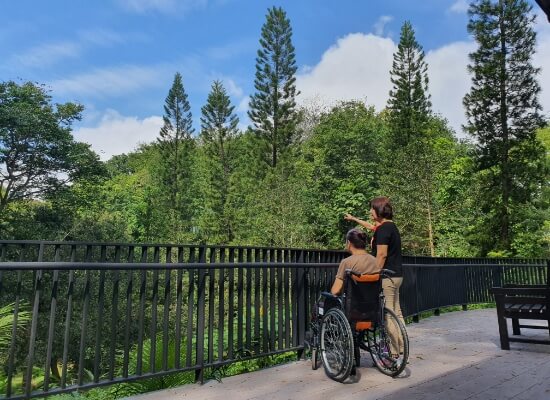
Therapeutic Gardens are outdoor gardens designed to meet the physical, psychological, and social needs of park users, incorporating design principles derived from scientific evidence. Visiting therapeutic gardens and participating in therapeutic horticulture programmes boast many benefits, from reducing depression to improving immunity and forging social connectedness.
Greening for
wellness
As of March 2023, there are now 10 therapeutic gardens across Singapore. NParks is also collaborating with grassroots organisations, agencies like HDB and healthcare institutions to co-create therapeutic horticulture nodes in public community spaces. In the past year, 24 such nodes were added, bringing the total number across the island to 56. These nodes provide easier access to greenery and nature for more in the community.
Within these spaces, healthcare professionals and caretakers can conduct horticultural therapy, a nature-based therapy specially designed to promote low intensity exercise, improve motor skills and foster positive social interactions amongst the elderly in particular.
Try your hand at a simple horticultural therapy project.
Planting seeds of
nature stewardship
in youth
Youth and children also have a part to play in greening Singapore. The Every Child A Seed programme has been going strong for a decade, providing a platform for students as young as seven to appreciate the challenges of the planting process while experiencing the joy of seeing their plants grow, contributing in their small way to Singapore's greening journey. 42,000 Primary 3 students received a plant starter kit consisting of a pack of seeds, soil, a pot and learning resources. To celebrate the programme's 10th anniversary, students also received an additional seed pack of native herbaceous plant species.
For the young adults, the Youth Stewards for Nature (YSN) initiative gives them the opportunity to work in groups on real-world projects related to horticulture, landscape architecture and environmental studies, amongst others. A total of 16 projects were undertaken by 120 youths in YSN 2023. Both NParks staff and YSN alumni provided guidance and support by serving as mentors. Since 2021, more than 300 youths have worked on over 60 projects.
Stemming from a YSN project, a group of passionate youths went on to lead the World Wildlife Day Regional Youth Symposium in Singapore, in March 2023, coinciding with World Wildlife Day. In line with the symposium’s theme of ‘Partnerships for Wildlife Conservation’, the symposium brought together some 170 like-minded participants from around the region to learn from one another and share their aspirations for youths in the nature and biodiversity conservation realm. A panel of experts were invited to share on wildlife management, policy development and other pressing wildlife related issues.
On the local front, youths who took part in the Green Friends Forum had the opportunity to interact with a horticulturist, an arborist and a landscape architect and took part in various hands-on activities. Within the span of the forum, participants were able to learn about the core skills and sciences that form the guiding principles to grow and sustain our verdant gardens, parks and streets.
With the lifting of most Covid-19 related restrictions, NParks resumed face-to-face learning journeys, school talks and teachers' training sessions, reaching out to over 10,000 students, educators and teacher trainees in the past year. Through these engagements, NParks staff were able to reach out to the younger generation on a range of topics from responsible pet ownership to marine biodiversity, and welcomed many more students into our green spaces.
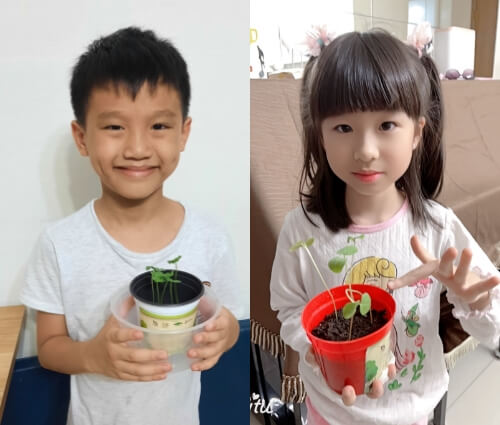
Young students show off the fruits of their labour, having tended to their plants for several weeks. The Every Child A Seed programme enables all students to experience growing a plant from the seed stage.
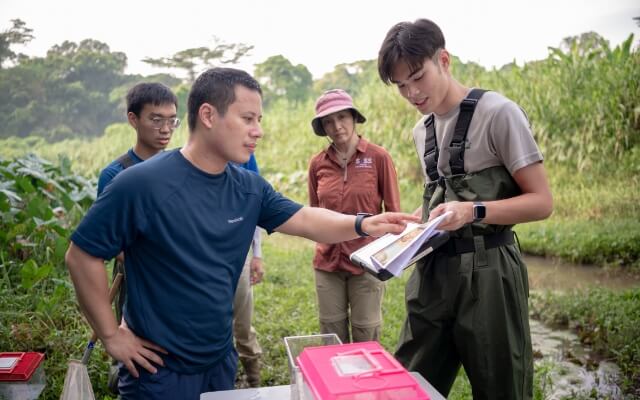
Minister for National Development and Minister-in-charge of Social Services Integration Desmond Lee (left) joins volunteers to examine results from a biodiversity survey, part of programmes where youths can actively contribute towards biodiversity conservation efforts.
Meet one of NParks' Youth Stewards for Nature alumni.
Making 'friends'
that support
greenery
An important community initiative is Friends of the Parks. In 2022, NParks completed 11 engagement projects under this programme for the design or redevelopment of parks such as Clementi Woods Park, Compassvale Park and Mount Faber Park.
The Friends of Clementi-Ulu Pandan Nature Corridor group was formed in 2021 to work on forest restoration and habitat enhancement works to strengthen the ecological resilience of two new recreational trails along the corridor. The group also developed walks to introduce residents to the area’s flora and fauna.
In other engagement efforts, the third in a series of City in Nature Conversations was held in January 2023. The workshops provided a platform for action groups to suggest ideas and co-create projects with NParks to restore nature into the urban environment.
Apart from in-person interactions, NParks also extended its digital reach, amassing a strong social media following across various social media channels such as LinkedIn (over 10,000 followers), TikTok (more than 11,000 followers and over 1.1 million views), Instagram Reels (61,700 followers and over 1.2 million views) and YouTube (more than 2 million views since April 2020).
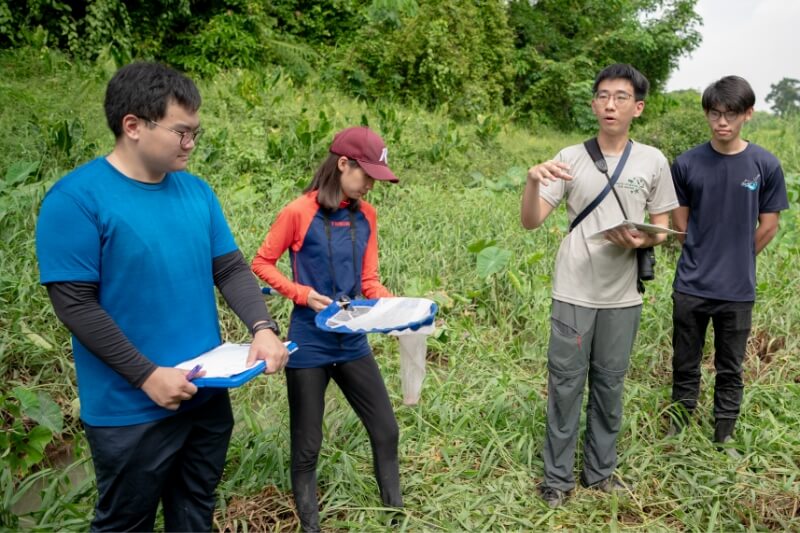
The Friends of Clementi-Ulu Pandan Nature Corridor group together with other volunteers carry out a BioBlitz along the Clementi Forest Stream, part of the upcoming Clementi Nature Trail. Results from the survey will guide sensitive habitat enhancements in the area.
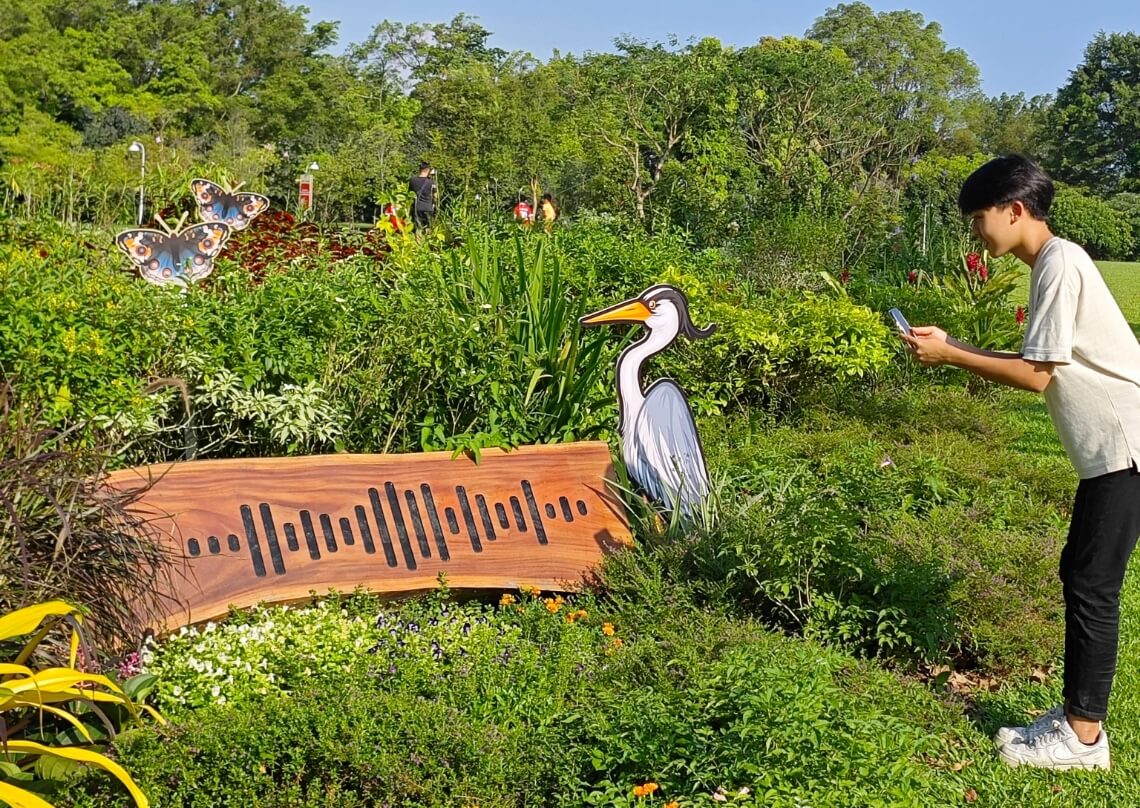
To raise awareness of City in Nature, recycled wooden Spotify ‘codes’ were installed in five parks in early 2023. Visitors can scan the code to enjoy our specially curated Park Beats playlist as they spend time in our green spaces.